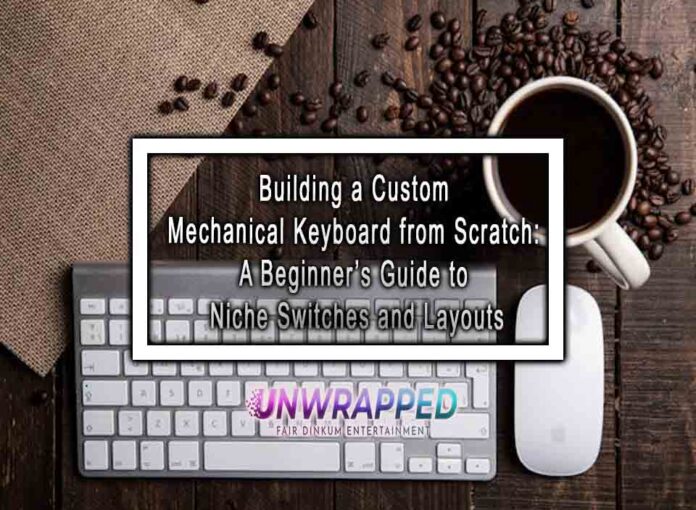If you’re a typing enthusiast, gamer, or productivity buff, you’ve likely come across mechanical keyboards. But have you ever considered building your own? Crafting a custom mechanical keyboard from scratch allows you to tailor every aspect—switch feel, layout, keycaps, and aesthetics—to your personal preferences. This guide will walk beginners through every step, from understanding niche switches and layouts to assembling your first custom board.
Why Build a Custom Mechanical Keyboard?
Increased Personalization:
Off-the-shelf keyboards can’t compare to the customization you get with a custom build. Choose from a vast array of switches, materials, and keycap profiles to perfect the typing experience.
Enhanced Typing Comfort and Efficiency:
By selecting an ergonomic layout or re-mapping keys, you can reduce strain on your wrists and fingers, boosting both comfort and long-term productivity.
Unique Aesthetic Appeal:
Custom builds stand out visually. Whether you love minimalist designs, RGB lighting, or artisanal keycaps, your keyboard can be a personal work of art.
Understanding Mechanical Keyboard Basics
What Are Mechanical Switches?
Mechanical switches are the heart of the keyboard. Unlike rubber dome keyboards, each key has its own mechanical switch. This design results in better tactile feedback, audible clicks or thocks (depending on the switch), and a more durable product.
Common Switch Types:
- Linear: Smooth keystrokes without tactile bumps. Popular among gamers.
- Tactile: Noticeable bump at the actuation point, providing feedback without being too loud.
- Clicky: Tactile feel plus an audible click. Loved by typists who enjoy audible feedback.
Niche Switches for a Personalized Touch
As the mechanical keyboard community grows, so does the selection of niche switches. Brands like Gateron, Kailh, and JWK offer switches with custom spring weights, unique stem materials, and specialized lubing for smoother actuation.
Examples of Niche Switches:
- Holy Panda Switches: Notable for their pronounced tactile bump and smooth, satisfying feel.
- Tealios or Tangerine Switches: Linear switches known for their buttery smooth keypresses.
- Silent Switches (e.g., Alpaca Silent): Designed for quiet operation, perfect for offices or shared workspaces.
When trying niche switches, buy a switch tester or a small batch first to ensure you love the feel before committing.
Choosing Your Layout: Beyond the Full-Size
Layouts define the keyboard’s footprint and key placement. While a 104-key full-size board is standard, you can explore niche layouts to optimize desk space and ergonomics.
Popular Layouts to Consider:
- Tenkeyless (TKL): Removes the numpad to save space but retains all essential keys for gaming and coding.
- 65% Layout: Compresses the keyboard further, removing function row and clustering arrow keys and navigation buttons.
- 60% Layout: Minimalist, leaving only the main character keys and modifiers. Functionality accessed via layers.
- Split Keyboards (e.g., Ergodox, Alice): Two separate halves promote a more natural wrist angle, reducing strain.
Matching Your Layout to Your Needs
- Programmers: Might prefer a TKL or 75% layout for easy access to function keys.
- Writers and Coders on the Go: A 60% or 65% layout is portable and efficient.
- Ergonomics-First Users: Consider split or angled layouts for comfort over long typing sessions.
Assembling Your Custom Mechanical Keyboard
Step 1: Gather Your Components
- Keyboard PCB (Printed Circuit Board): The “brain” of your keyboard; ensure it’s compatible with your chosen layout and switches.
- Case: Can be aluminum, acrylic, wood, or polycarbonate. A well-weighted case adds stability and sound dampening.
- Plate: Sits between switches and PCB, providing rigidity. Materials like brass, aluminum, or carbon fiber can alter typing feel and sound.
- Switches: Niche or mainstream switches as per your preference.
- Keycaps: Explore double-shot PBT, dye-subbed legends, and custom artisan caps.
- Stabilizers: Keep larger keys (Enter, Spacebar, Shift) steady and rattle-free.
Step 2: Preparation and Tools
Essential Tools:
- Soldering iron and solder (if your PCB isn’t hot-swappable)
- Switch puller and keycap puller
- Screwdrivers
- Lubricants (Krytox or Tribosys) for lubing switches and stabilizers
- Anti-static mat and proper lighting
Pre-Build Checklist:
- Test PCB functionality before assembly using software like VIA or QMK Configurator.
- Lubricate switches and stabilizers for smoother operation and reduced noise.
- Apply sound-dampening foam inside the case if desired.
Step 3: Soldering or Installing Switches
- For Hot-Swap PCBs: Simply push in switches after aligning pins with the PCB sockets.
- For Soldered Builds: Insert switches into the plate and PCB, then solder each switch pin. Ensure a clean solder joint and be patient and precise.
Step 4: Mounting the Plate and Case Assembly
- Align the plate with the PCB and carefully fit everything into the case.
- Secure the assembly with screws, ensuring no wires or components are pinched.
Step 5: Adding Keycaps and Final Touches
- Press keycaps onto their corresponding switches.
- Connect the keyboard to your computer and verify all keys function correctly.
- Make final layout adjustments with firmware tools like QMK or VIA to program custom layers and macros.
Fine-Tuning Your Custom Experience
Adjusting Layout Layers:
If you chose a compact layout, you can assign secondary functions to keys via layers. For example, your Fn key might trigger a layer for arrow keys, media controls, or macros.
Sound Profile:
Experiment with foam inserts or switch films to alter the keyboard’s sound. Some enthusiasts enjoy a “thocky” low-pitched sound, while others prefer a crisp, higher-pitched click.
Aesthetic Upgrades:
Add artisan keycaps, RGB backlighting, or unique cable coils to make your keyboard an extension of your style.
Maintaining Your Custom Mechanical Keyboard
- Regular Cleaning: Remove keycaps to dust off switches and wipe the surface with a microfiber cloth.
- Switch Maintenance: Over time, you may want to re-lube switches or replace those that wear out.
- Firmware Updates: Keep your firmware updated for compatibility and advanced programming features.
Conclusion: Embrace the Custom Keyboard Journey
Building a custom mechanical keyboard from scratch is about more than just assembling components—it’s about crafting a device that enhances your daily computing experience. By carefully selecting niche switches, exploring unique layouts, and taking the time to perfect every detail, you’ll end up with a keyboard that feels, looks, and sounds exactly how you want it to. As you learn more, don’t hesitate to experiment with new components, layouts, and customization techniques. Your perfect typing experience awaits.
See Also:Setting Up a RISC-V Developer Environment: A Step-by-Step Guide for Hobbyists and IoT Projects










